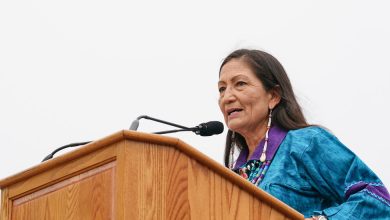From Her First $100K to 3 Million Followers

The women logged on from Alaska, Florida and points in between, excited and nervous. The energy was palpable in the chat stream, which bubbled with the kind of quick and candid confessions that emerge in a room of virtual strangers.
One said she was so teary-eyed with happiness that someone must be cutting onions. Another said she was so wound up she could vomit. Encouragement and expletives flowed freely. But one user’s request to Tori Dunlap got directly to the point: “Teach me how to make money!!!!!!!”
By the end of hourlong workshop, Ms. Dunlap — who regularly reaches nearly 2.8 million followers through TikTok and Instagram — had helped roughly 170 women invest nearly $20,000. For many, it was the first time they had ever bought a share.
Talking about money, Ms. Dunlap said in an interview later, can be “the most boring thing in the world.” And though she cringes at the word empowerment, that’s what money is about: the ability to fund causes you support, travel and spend as you like, and make — or break — personal relationships without consideration of the financial implications.
“It’s what money can buy you,” said Ms. Dunlap, 27, who dispenses financial tips and career advice, sometimes in T-shirts with slogans like “Smash the Patriarchy” or “Financial Feminist,” the title of a podcast starting again this month as well as a book due out in December.
She eschews American tropes about bootstraps that don’t work for a generation whose wages haven’t kept pace with tuition bills or the cost of living, and finds common criticisms of younger Americans, like that they’re struggling because they don’t work hard or buy too many lattes, offensive.
“That is so insulting to the single mom who works harder than any of us but can’t afford her rent,” Ms. Dunlap said.
It’s an appealing message for many young people, helping make Ms. Dunlap a popular financial guru whose business grossed more than $3.4 million last year, she said, spurred on by a pandemic that has raised the popularity of investing and swelled the ranks of self-made online experts.
But rather than rallying behind meme stocks or the latest hot crypto trend, she is part of a growing tribe of largely millennial women aiming to change the narrative around women and money, often by drawing from their own experiences. There’s Berna Anat, a.k.a. Financial Hype Woman; Melissa Jean-Baptiste, the Beyoncé of Personal Finance, also known as Millennial in Debt; Delyanne the Money Coach; and Haley Sacks, founder of Mrs. Dow Jones and Finance Is Cool.
They are latter-day Suze Ormans without the latte shaming, using TikTok and podcasts instead of TV and radio to dispense practical financial guidance. With popularity comes myriad ways to monetize it, from striking book deals to running workshops. There’s also the potential to secure lucrative corporate sponsorships, which caused waves nearly two decades ago when Ms. Orman appeared in a “lock and roll” financing ad for General Motors.
Larger financial firms were long wary of social media, even as many companies embraced apps like Instagram to connect with customers. But TikTok has become a force they cannot ignore, consultants said, and firms are amplifying their presence there. State Farm, for example, skipped the splashy Super Bowl ads this year and instead created its first-ever TikTok challenge.
“I have spent so much time trying to convince clients to work on social media and embrace it,” said Ben Cathers, a consultant who works with financial firms at Hootsuite, a social media management company. “And now they’re saying, ‘OK, how do we create TikTok videos today?’”
Since her first TikTok post less than two years ago, Ms. Dunlap has cultivated enough of a following — largely women in their 20s and 30s — to command $15,000 per video from corporate customers seeking a direct line to her audience. But her latest partnership, with an app, called Treasury, started by two others, goes further.
With its beginner’s workshop and portfolio-sharing tools, the app bills itself as “a nonjudgmental investing community” aimed at women. The goal is to help them overcome feelings common to many would-be investors who are cautious — or even paralyzed — by the idea of jumping into a subject they haven’t mastered.
Even if some women hesitate before getting started, they often gain an edge later: Research has suggested women tend to be better savers and investors than men.
“I was the friend every female friend came to,” Ms. Dunlap said. “And I also became more committed to managing my own money. I realized I had a passion for teaching women the same thing.”
It started, naturally, as a side hustle.
In late 2016, Ms. Dunlap was working for a security firm when she started blogging. Within a couple of years, she began to focus on money and set a goal: $100,000 in savings at age 25. Readers could follow along while she tried to reach her target, which she hit in September 2019, two months after her birthday.

Ms. Dunlap hosts a one-hour “Investing 101” workshop on Treasury, where she discusses the difference between stocks and bonds before participants make their first purchase.Credit…Chona Kasinger for The New York Times
That caught the attention of producers at “Good Morning America,” and by the end of the year, Ms. Dunlap had quit her job running social media at a start-up and turned her attention to her budding business of financial and career coaching.
The pandemic arrived, and her company, Her First 100k, quickly built an even larger online following. Her formula: Posts should be entertaining (one of her majors was theater), educational (there she is negotiating a job offer) and aspirational (who doesn’t want to write their book in an Italian villa?).
But at the core is practical advice that Ms. Dunlap said grew out of responsible financial habits learned from her parents, who saved religiously and never spent mindlessly during her childhood in Tacoma, Wash.
An only child, Ms. Dunlap remembers walking into the den, where she could reliably find her mother balancing the checkbook on the 13th and the 21st of each month. Her father’s scripts for negotiating everything from the cable bill to parking fees at hotels lodged in her brain.
“These are the sorts of behaviors I saw,” she said. “I just thought that was normal.”
Ms. Dunlap’s father also inspired her entrepreneurial spirit. When she was 9, he made her an offer she couldn’t refuse: a three-slot candy vending machine, and a $300 loan to buy it from him. She paid it off in roughly two years.
They spent one Saturday a month driving around town in his Chevy pickup, refilling her growing stable of machines. She had to buy candy in bulk — she was initially crestfallen after learning she could have halved her expenses at Costco — and later pitched local retailers to secure spots for the machines, again modeling her father’s approaches. She drafted three-sentence contracts in Microsoft Word, and had a checkbook by the time she was 11.
Profits went to her college fund — she said graduating debt free from the University of Portland had been a major factor in her ability to save that first $100,000 — and she owned 15 machines when she graduated from high school. At 20, she sold the turnkey business to a 10-year-old, also named Tori, for about $1,700.
Treasury, which has positioned itself between D.I.Y. investing and roboadvisers that create and manage automated portfolios, is considerably more complicated than quarter-a-pop vending machines. It’s akin to an investing club: Users hook their online brokerage accounts into the app, which tracks their purchases — TD Ameritrade users can trade in the Treasury platform directly — and allows them to see how others’ portfolios (including Ms. Dunlap’s) are divvied up.
During the workshops, she cheers users on as they make their purchases, hopefully from a list of popular index funds. She makes it clear she’s not offering professional advice — she calls herself a financial educator — so the process is something like investing with the encouragement of a well-informed friend.
Friendly advice isn’t necessarily cheap, though. The initial one-hour workshop costs $99, and users can add a $12.99 monthly subscription to get early access to roughly one workshop a month (for example, on getting started with a tax-advantaged account like a Roth I.R.A.), other events and content.
By comparison, putting $500 in a popular portfolio at the roboadviser Betterment costs just $1.25 a year (0.25 percent of the money invested, plus a tad more for the underlying investments). Ellevest, a roboadviser geared toward women, charges $12 annually for its most basic investment plan, and includes extras like online workshops and email courses from certified financial planners.
“There are cheaper options, and yet so many people just don’t invest, period,” said Treasury’s chief executive, Elias Rothblatt, who founded the service with Ivar Vong.
He said Treasury’s goal was to give users the nudge they needed to get started. “If you put $50 or $100 into a low-cost investment and that makes you feel like, ‘Oh, cool, I learned about investing,’ then that is a major win,” he said.
The service, which became available to the public in January, has drawn 2,000 users who have invested nearly $13.5 million. In 2021, it helped people invest $4 million of that during its private beta testing. More seasoned investors also see the appeal: Start-up funders, led by Bloomberg Beta, have put in more than $1.25 million.
Nearly 270 people took part in that February session. Ms. Dunlap started with a pep talk before diving into explanations dotted with metaphor. She likened buying shares of Amazon, for example, to “owning a grain of sand on Bezos’ beach.”
A little blue counter ticked away in the corner of the screen, tracking total dollars invested as participants made purchases, buying shares of investments like the Vanguard Total World Stock E.T.F., State Street’s Global Diversity Index E.T.F. and more. More than half bought something in that hour, spending roughly $120 each — a modest sum, but a meaningful first step.
“This is not TJ Maxx’s candle aisle,” Ms. Dunlap joked as trades piled up in the chat stream. “Please make smart choices.”




